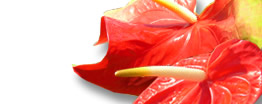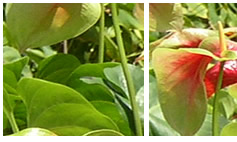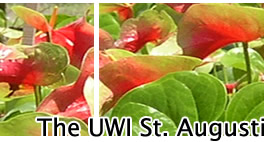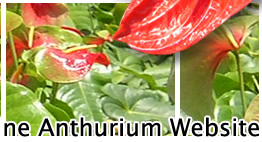 |
 |
||||
 |
 |
 |
|||
|
|
Postharvest Operations Harvesting stage The maximum vaselife occurs when the inflorescences (spadix) are harvested with three-quarters or more of the true flowers open. The Caribbean farmers commonly refer this to as the time when the spadix is ¾ ripe. This is the stage that the international markets require the cut-flowers to be harvested. The cut-flowers must be cut with a sharp, sterile knife (sterilised by dipping in isopropanol alcohol), and placed on trolleys containing vases with clean water. This ensures that the cut-flowers can still transpire, hence maintaining freshness. Cut-flowers must be taken to a packing shed immediately to maintain maximum freshness. The packing shed should preferably be air-conditioned. The cut-flowers should be gently cleaned with clean water and water should be replaced regularly. After this the cut-flowers may be sold immediately or packaged for export. Handling and storage Once the cut-flowers have reached the air-conditioned packing shed, there should be persons to first determine the quality of the cut-flowers and any ones that do not meet the standard criteria for sale should be immediately removed and placed in a separate area. The standard cut-flowers should then be cleaned with clean water, and sorted according to size by measuring the spathe width, which is the perpendicular directly behind the spadix. Visual determination will come with experience. The following table gives a guide as to the standards practiced by Caribbean farmers:
The sorted cut-flowers should be cut again under water with a clean sharp knife at a 45 degree angle and placed in vases containing water according to size. Keep the varieties separate. Packaging for export Cut-flowers are packaged according to size. A roll of white paper can be purchased as well as a paper shredder. The shredded paper is first moistened. Some paper is placed at the bottom of the box. Then cut-flowers are packaged in such as way that one never touches another. This is done again using wet shredded paper. To maximise the number of cut-flowers per box, the cut-flowers are packed one next to and above another in opposite orientation. The boxes are then closed and taped all around with clear tape, and placed in an air-conditioned vehicle for transportation to the airport. Vaselife extension All the precautions taken at harvesting and packaging ensure that the cut-flowers maintain their freshness during the transportation stage. Although several experiments were carried out to determine the effects of some common agents used to extend vaselife, none proved to be of any use and in fact some popular ones decreased vaselife. However, one of the noted ways for extending vaselife is re-cutting the peduncle base about 5 cm at a 45o angle under water and placing the cut-flowers in fresh water, preferably in another clean vase. Then the initial vase may be cleaned with clean water, then soaked in 10% bleach for 10 minutes, rinsed again and left to dry before reusing it. This method can extend vaselife in some varieties by up to 3 weeks. |
||||||||||||||||
© 2004 - The University of The West Indies. All rights reserved. Disclaimer | Privacy Statement Telephone: (868) 662-2002 Fax: (868) 663-9684 |
|||||||||||||||||